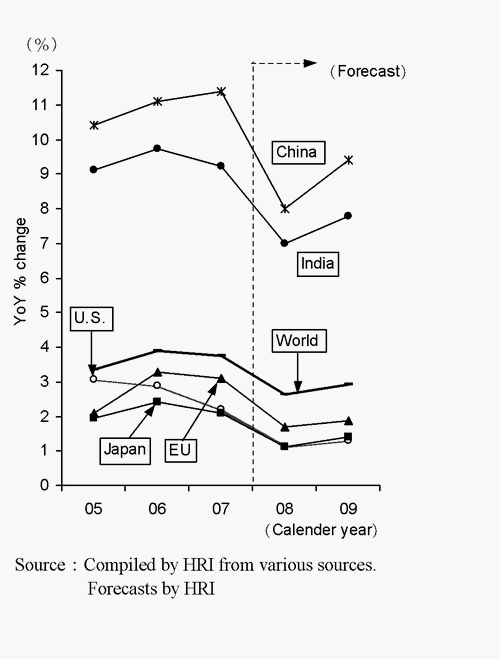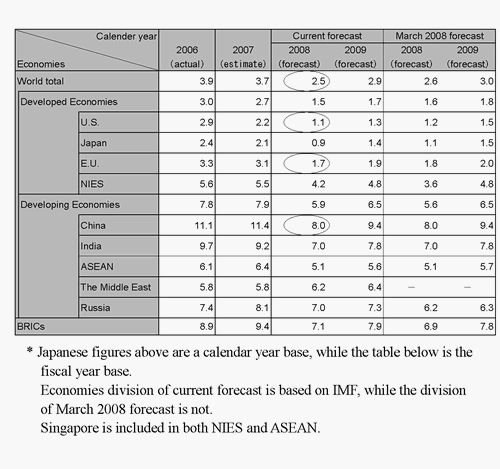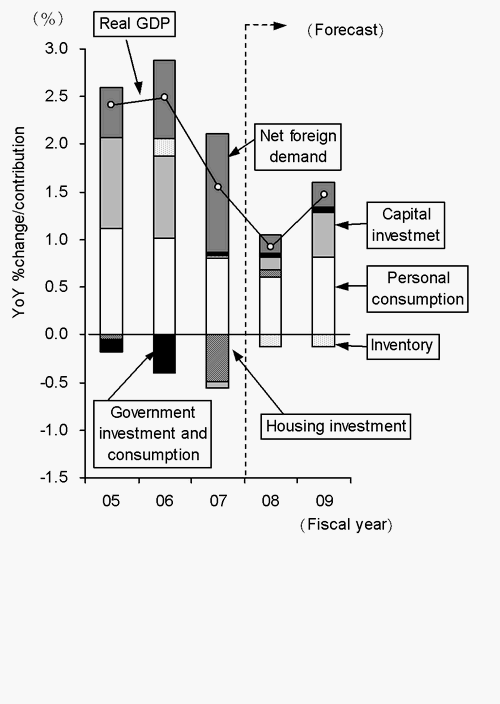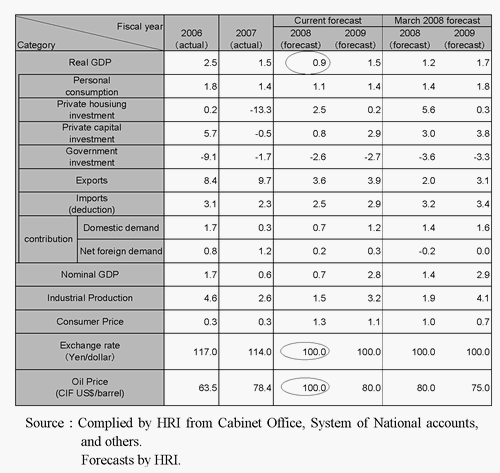Latest economic forecasts for Japan, the U.S., Europe, and China, etc
The world’s major financial institutions have suffered from the total loss of 300 billion dollars so far, due to the sub-prime loan crisis. Although the situation is still unstable, the financial markets may have a good chance of getting out from the worst period, thanks to the capital reinforcement of 150 billion dollars from the Sovereign Wealth Funds (SWFs). However, this financial turmoil will continue to put the negative impacts on the economy up to the end of year 2009. Another important fact is the sharp rise of prices, especially of the primary goods, e.g. crude oil, which is mainly caused by the shifts of excess cashes from the financial markets to the commodity markets as an outcome of the sub-prime loan crisis. In this regard, the adjustment of world economy has entered into the next phase: crisis of natural resources and the food supplies. Oil price has been rocketed up to US$135 per barrel (as of May 21st, 2007), which elevated the concerns toward inflation across countries. If this price level lasts, the damage on the U.S. and Japanese economies would be as heavy as in the case of the Second Oil Crisis between 1979 and 1980, even if considering improvements in efficiency of oil consumption measured by unit oil consumption per real GDP. The rise of food prices has caused large anxieties especially in the developing countries. Currently, the commodity markets have become similar to the financial markets in the sense that the pension funds have been actively investing. However, the commodity markets are small compared with the financial markets, so price volatilities are very large in a small pond with giant whales struggling. If China’s economy slows down after Beijing Olympics, the demand for natural resources and foods would be eased and hence decrease the prices. The future of Chinese economy will be the next focus of world economy.
While the number of non-farm payrolls have decreased for 4 consecutive months from January 2008, the U.S. economy might have entered into a recession from the first quarter of 2008. The sub-prime loan crisis is projected to put a downward pressure on the U.S. economy until the end of year 2009, mainly due to financial institutions’ loan tightening. Stagflation risk remains, as it is hard for FRB to raise interest rates under worsening economic conditions. In this forecast, real economic growth rate of U.S. economy was revised down to 1.1% (from 1.2% in the previous forecast) for 2008.
The E.U. economy also began to slowdown, following the deteriorating U.S. economy. The inflation rates remain higher than acceptable levels, and the monetary tightening policies are underway. The projected real GDP growth rate of the E.U. has therefore been revised down to 1.7% (from 1.8% in the previous forecast) for 2008.
The economic growth rate of China still marked double-digits, 10.6% in the first quarter of 2008. However, rapid slide in the stock prices and the earthquake in Sichuan Province are increasing instability of economic conditions. The monetary tightening will be intensified to control the rising inflation, and the yuan will continue to appreciate, consequently it is unavoidable for the real economic growth rate to slowdown to single-digit from double-digit growth which has continued since 2003. The China’s real GDP growth rate is projected to decelerate rapidly to the range between 6 and 7% after the Beijing Olympics, and the 2008 economic growth rate is forecasted to be 8.0% (unchanged from 8.0% in the previous forecast).
On the other hand, in the resource exporting countries/regions such as Middle East and Russia, the economies are growing strongly, thanks to a jump in the price of primary commodities such as crude oil. After all, the forecasted growth rate of world economy in 2008 was revised down to 2.5% (from 2.6% in the previous forecast). The economy will not fall down drastically as it did when the IT bubble collapsed in 2001 (1.5% growth) under the standard scenario assuming that the average price of crude oil in 2008 will be US$100/barrel. Under the risk scenario assuming that the oil price will be US$150/barrel, the growth rate of the world economy would be down to 1.4%, and the oil price might fluctuate wildly.
In Japan, domestic demand is weak, as corporate profits and personal incomes are getting depressed due to outflow of the income caused by rising prices in imported primary commodities, e.g. crude oil. Imported inflation leads hike in all kinds of prices, e.g. gasoline price, therefore the forecasted CPI (Consumer Price Index) for fiscal year 2008 was revised up to 1.4% (from 1.0% in the previous forecast). Despite of the soar in import prices, the wages will not go up. As corporate profits and personal incomes get squeezed, the forecasted GDP deflator in FY 2008 was revised down to -0.2% (from 0.1% in the previous forecast). In this sense, the economy is still in the deflation. Although the export to resource exporting countries is firm, the economy is projected to enter into a recession reflecting the weak domestic demand. The forecasted growth rate of Japan’s economy in FY 2008 was revised down to 0.9% (from 1.2% in the previous forecast).



